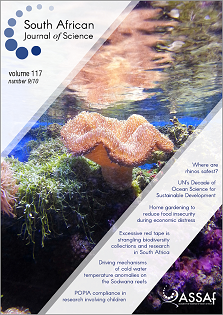Cold water temperature anomalies on the Sodwana reefs and their driving mechanisms
DOI:
https://doi.org/10.17159/sajs.2021/9304Keywords:
coral reefs, Sodwana reefs, hydrodynamics, temperature anomalies, coral bleachingAbstract
The Sodwana reef system experiences short-term temperature fluctuations that may provide relief from bleaching and be crucial in the future survival of the system. These temperature fluctuations are best described as cold water temperature anomaly events that occur over a period of days and cause a drop in temperature of a few degrees on the reef. We explored the statistical link between the temperature anomalies and the regional hydrodynamics to elucidate the driving mechanisms of the temperature anomalies around Sodwana. Temperature measurements taken between 1994 and 2015 on Nine‑Mile Reef at Sodwana show that temperature anomalies occur on average three times per year at Sodwana and predominantly during the summer months. A conditional average of altimetry data at the peak of the temperature anomalies showed the emergence of a negative sea surface height (SSH) anomaly pattern and associated cyclonic eddy just offshore of the Sodwana region. The cyclonic eddies associated with the temperature anomalies originate on the southwestern edge of Madagascar and migrate westwards until they interact with the African coastline at Sodwana. Instantaneous altimetry SSH fields over the 21-year period were cross-correlated to the conditionally averaged SSH field within a 2° region around Sodwana. It was found that 33% of the temperature anomalies at Sodwana were not associated with the presence of cyclonic eddy systems. This finding suggests that an offshore cyclonic eddy interacting with the shelf is not the sole driving mechanism of the temperature anomalies.
Significance:- Cold water temperature anomalies that occur at Sodwana are believed to play an important role in the sustainability of the coral reefs; however, their driving mechanisms are not yet well understood. We identified the annual frequency and seasonal occurrence of the temperature anomalies at Sodwana. Conditionally averaged sea surface heights delineated regional hydrodynamic patterns associated with the temperature anomalies. These hydrodynamic patterns could be a possible driving mechanism to be explored in future research. Previous research associated these temperature anomalies with a single regional hydrodynamic pattern around Sodwana; however, additional hydrodynamic patterns associated with the temperature anomalies have been found based on the length of the data sets used in this study.
Published
Issue
Section
License

This work is licensed under a Creative Commons Attribution 4.0 International License.

All articles are published under a Creative Commons Attribution 4.0 International Licence
Copyright is retained by the authors. Readers are welcome to reproduce, share and adapt the content without permission provided the source is attributed.
Disclaimer: The publisher and editors accept no responsibility for statements made by the authors
How to Cite
- Abstract 901
- PDF 508
- EPUB 178
- XML 168
Funding data
-
National Research Foundation
Grant numbers UID: 127361 -
eThekwini Municipality
-
Inyuvesi Yakwazulu-Natali












.png)